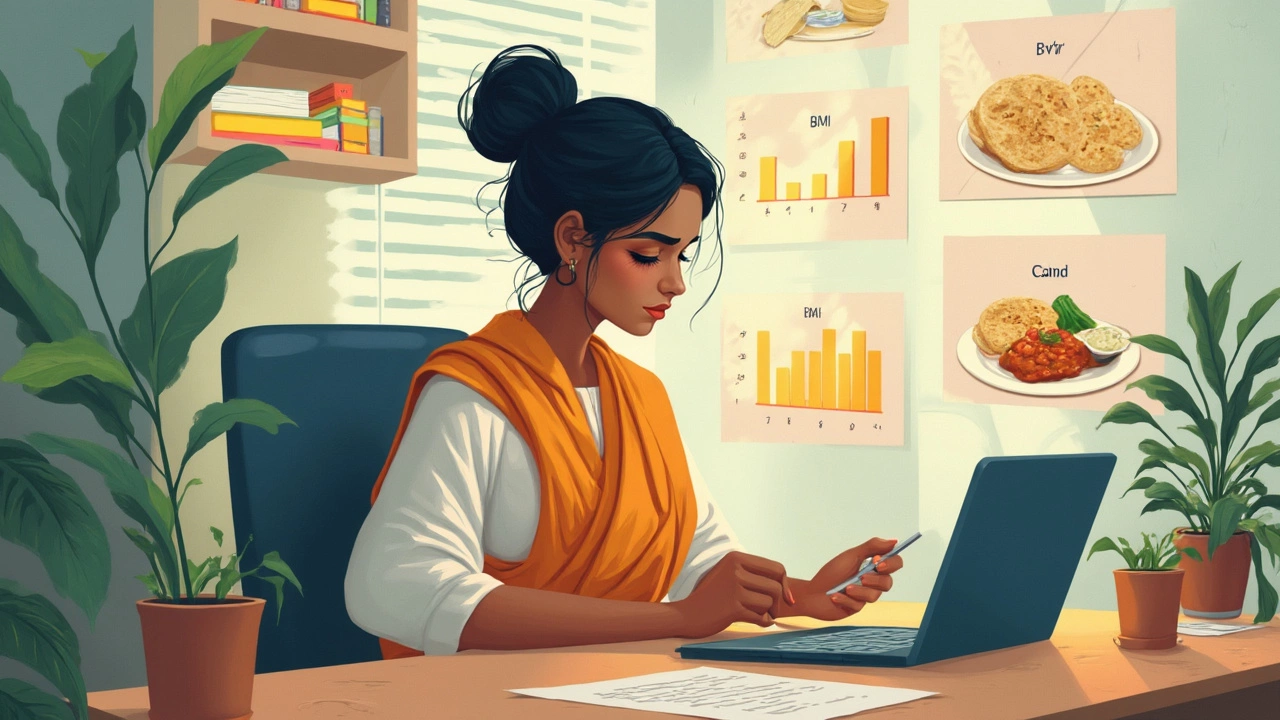Chapati and Your Diet: How Many Should You Eat Every Day?
 Feb, 27 2025
Feb, 27 2025
Ever wondered how many chapatis you should actually eat in a day? You're not alone! Chapatis are a staple in many diets, but it's tricky to figure out the right amount for your health needs.
Start by grasping the basics: a single roti comes with approximately 70-80 calories. A typical adult diet might consist of several rotis per day, depending on activity level and dietary goals. So how do you calculate the right number for you?
First off, consider your Body Mass Index (BMI). This nifty index gives a quick look at whether you're in a healthy weight range. You can calculate your BMI online, and it's a great starting point for personalizing your diet plan. Combine it with a calorie calculator to get a tailored approach.
- Understanding the Basics of Roti
- Calculating Your Chapati Intake
- Role of BMI in Diet Planning
- Local Variations and Legal Notes
- Practical Tips for Everyday Eating
Understanding the Basics of Roti
Think of roti as the bread and butter of many South Asian cuisines. Made primarily from whole wheat flour, water, and sometimes a pinch of salt, it's flatbread with a lot of history and variety.
What Makes a Good Roti?
The essentials for a top-notch roti are simple: good quality flour, enough kneading time, and the right cooking technique. Start by mixing whole wheat flour with water to form a pliable dough. Let it rest to ensure it's soft when cooked.
- Mix the flour with water and a pinch of salt. Knead it into a smooth dough.
- Let the dough rest for at least 15 minutes.
- Roll small balls into thin circles using a rolling pin.
- Cook on a preheated pan until both sides puff and are slightly golden.
For those in Sydney, various local shops offer imported flours from India and Pakistan, known for a finer texture.
Nutritional Value
On average, calories in one roti range from 70 to 80, depending on the size and thickness. Whole wheat is rich in fiber, making it a healthier option. Aim for 1-2 depending on your energy requirements, which you can find using a calorie calculator.
Legal Considerations
While making rotis at home, remember, selling homemade foods can be subject to health regulations. In Australia, there are food safety standards to consider if you're thinking of starting a chapati business.
Staying informed about these key points ensures that not only do you enjoy your food, but you're also abiding by local health policies.
| Nutrient | Per Roti |
|---|---|
| Carbohydrates | 15g |
| Protein | 3g |
| Fat | 0.4g |
Calculating Your Chapati Intake
Want to know how many chapatis you should munch on daily? Here's a quick guide to help you figure it out. Bear in mind, this is just a starting point and might require adjustments to suit individual needs.
Step 1: Determine Your Caloric Needs
Your first step is to figure out your daily calorie requirement. A handy calorie calculator can do wonders here. Input personal details like your age, gender, activity level, and current weight. It'll spit out an approximate number of calories you should aim for each day.
Step 2: Consider the Calories in One Roti
Each roti (or chapati) typically contains around 70-80 calories. Keep this in mind as you plan your meals. If you're having a 2,000 calorie diet, figure out how much of it comes from rotis versus other food items.
Step 3: Factor in Your BMI
Your Body Mass Index (BMI) is a good indicator of your overall health. If your BMI is within a healthy range, you might settle closer to the average intake of six rotis daily. For more personalized adjustments, consult a nutritionist.
Legal and Local Considerations
In Australia, legal standards require transparent labeling of food items. Always check packaging to ensure you're aware of ingredients, especially if you have dietary restrictions. Locally, varied grains and flour types may be used, affecting caloric content.
Practical Tips
- Consider portion control—maybe a curry and salad to balance out meals.
- If increasing activity levels, you might tweak up your intake a tad.
- Remember, dietary changes should be gradual to give your body time to adjust.

Role of BMI in Diet Planning
Understanding your Body Mass Index (BMI) is crucial when figuring out how many chapatis you should eat daily. It’s not just a number; it’s a guideline for maintaining a healthy lifestyle.
BMI is calculated using your height and weight. It gives a snapshot of whether you're underweight, normal, overweight, or obese. This plays a big part in diet planning because your calorie needs vary greatly based on this number. Use your results to adjust how many calories you're consuming. For instance, someone with a BMI in the overweight category might want fewer calories than someone who's in the normal range.
Step-by-step Guide to Using BMI for Diet Planning
- Calculate your BMI using an online calculator or a simple formula: weight in kilograms divided by height in meters squared.
- Determine your BMI category—underweight, normal, overweight, or obese.
- Assess your caloric needs using a calorie calculator and adjust based on your BMI.
- Customize your diet, keep an eye on your everyday intake of chapatis, and balance them with some veggies, proteins, and healthy fats.
In Australia, guidelines from the National Health and Medical Research Council emphasize the importance of personalized diet plans, including those involving chapatis, which are a popular part of Indian and Pakistani cuisines enjoyed across the country. There aren't specific legal restrictions on chapati consumption, but dietary guidelines encourage a balance of nutrients.
| BMI Category | Recommended Daily Calories |
|---|---|
| Underweight | 2500 - 3000 |
| Normal | 2000 - 2500 |
| Overweight | 1500 - 2000 |
| Obese | 1200 - 1500 |
To sum it up, BMI is an essential tool in planning your diet. When sorting out your daily chapati intake, keeping your BMI in mind will help ensure you're hitting your health goals efficiently.
Local Variations and Legal Notes
Chapatis are all about local flair and tradition. How you make them can vary greatly, from the thin and crispy ones popular in South India to the chunkier, softer version in the north.
Here’s a simple guide on how to tailor chapatis to your taste while keeping an eye on legal aspects:
Step-by-Step Guide to Local Chapati Styles
- Thin Rotis: Use less dough and roll with a light hand to create thin, almost transparent layers.
- Thick Rotis: Roll with more dough and press gently to maintain thickness, sealing in moisture.
- Add Flavors: Across Australia, locals often infuse their chapatis with spinach or beetroot for extra nutrients.
Understanding Legal Aspects
When making chapati products for sale, it’s key to know food safety regulations. According to Food Standards Australia New Zealand (FSANZ), packaged food items must display ingredient lists and allergy warnings. So, if you're thinking of selling your homemade chapatis, keep those labels clear!
“Understanding local cultural preferences is as critical as adhering to food safety regulations.” – Food Industry Magazine
Why Local Ingredients Matter
For the best chapatis, use fresh, local Aussie wheat flour. It's not only healthier but supports sustainability and local farmers too!
Calories in One Roti may differ because local produce, soil, and weather can tweak nutrition profiles. This makes using a calorie calculator an excellent tool for precise dietary planning.
| Type | Approximate Calories |
|---|---|
| Thin Roti | 70 |
| Thick Roti | 80 |

Practical Tips for Everyday Eating
If you're aiming for a diet that rocks your health goals, incorporating roti in a balanced way is key. Here’s how you can make it work.
1. Start with Portion Control
It's easy to forget portion sizes when you love chapatis, but it's crucial to stick to what's right for your body's needs. Use a calorie calculator to check your daily needs and figure out where chapatis fit in. Remember, a chapati holds around 70-80 calories, so tally them up based on your other meals too.
2. Pair with Nutrient-Rich Sides
To keep your meal balanced, pair those chapatis with veggies, daal, or lean proteins. These provide fiber and much-needed nutrients. In Australia, sourcing fresh veggies from local markets can add vibrancy and health to your plate.
3. Adjusting Based on BMI
Your Body Mass Index (BMI) plays a part in deciding quantities. If you're aiming to shed some kilos, consider reducing the number of chapatis and adding more salads. Utilize the BMI insights to keep track and adjust accordingly.
4. Think About the Timing
Eating roti during the day, especially lunch, can be great for energy. Ever notice how heavy dinner makes you sluggish? Make midday meals your main deal so you’re active afterward. Dinner can do with fewer carbs.
5. Be Mindful of Legal Labels
Food labeling laws in Australia ensure we know what’s going into our food. Opting for wholemeal or multigrain roti gives a healthier punch, thanks to extra fiber and nutrients. Check the labels to make sure choices align with what you need.
6. Local Tips and Tricks
In Sydney, there's a growing trend of using alternative flours like chickpea or quinoa in a chapati, giving a gluten-free spin. Switching it up as per dietary needs or preferences makes sure you don’t get stuck in a rut!
These practical tips aren’t just about eating chapatis. It's about smart, flexible choices that keep your diet balanced and enjoyable.